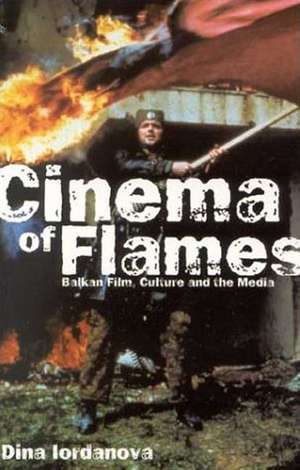Cinema of Flames: Balkan Film, Culture and the Media
Autor Dina Iordanovaen Limba Engleză Hardback – aug 2001
Preț: 601.85 lei
Preț vechi: 699.83 lei
-14% Nou
Puncte Express: 903
Preț estimativ în valută:
115.17€ • 121.10$ • 95.16£
115.17€ • 121.10$ • 95.16£
Carte disponibilă
Livrare economică 27 martie-10 aprilie
Preluare comenzi: 021 569.72.76
Specificații
ISBN-13: 9780851708485
ISBN-10: 085170848X
Pagini: 322
Dimensiuni: 153 x 234 x 35 mm
Greutate: 0.71 kg
Ediția:2001
Editura: British Film Institute
Colecția British Film Institute
Locul publicării:London, United Kingdom
ISBN-10: 085170848X
Pagini: 322
Dimensiuni: 153 x 234 x 35 mm
Greutate: 0.71 kg
Ediția:2001
Editura: British Film Institute
Colecția British Film Institute
Locul publicării:London, United Kingdom
Cuprins
War
in
the
Balkans.-
Moving
images;
are
the
Balkans
admissible?.-
The
discourse
on
Europe.-
Narrating
the
Balkans.-
Narrative
and
putative
history.-
Balkan
film
history.-
Kusturica's
underground.-
Taking
sides.-
Violence
'violated
trust',
indoctrination
and
self
destruction.-
Villains
and
victims.-
Representing
women's
concerns.-
Gypsies
looking
at
'them',
defining
oneself.-
Visions
of
Sarajevo.-
Migrating
mind
and
expanding
universe.-
Aftermath?.
Notă biografică
Dina
Iordanova
is
a
Lecturer
at
the
Centre
of
Mass
Communication
at
the
University
of
Leicester
and
an
editor
of
The
BFI
Companion
to
Eastern
European
and
Russian
Cinema
(2000)
Textul de pe ultima copertă
First
study
of
cinema,
media
and
the
Balkan
wars;
Wide-ranging
view
of
politics
and
culture
of
the
region;
The
break-up
of
Yugoslavia
triggered
a
truly
international
film-making
project.
Underground,
Ulysses'
Gaze,
Before
the
Rain,
Pretty
Village,
Pretty
Flame
and
Welcome
to
Sarajevo
were
amongst
a
host
of
films
created
as
the
conflicts
in
the
region
unravelled.
These
conflicts
restored
the
Balkans
as
a
centrepiece
of
Western
imagery
and
the
media
(especially
cinema)
assumed
a
leading
but
ambiguous
role
in
defining
it
for
global
consumption
through
a
narrow
range
of
selectively
defined
images.
Simultaneously,
a
lot
of
the
high-quality
cinematic
and
television
work
made
in
the
region
(much
of
it
discussed
in
this
book)
remains
relatively
unknown.
Cinema
of
Flames
attempts
to
go
deeper
than
the
imagery
and
address
some
of
the
general
concerns
of
the
cross-cultural
representation
and
self-representation
of
the
Balkans:
narrative
strategies
within
the
context
of
Balkan
exclusion
from
the
European
cultural
sphere,
the
cosmopolitan
image
of
Sarejevo,
diaspora,
and
the
representations
of
villains,
victims,
women,
and
ethnic
minorities,
all
considered
in
the
general
context
of
Balkan
cinema.
'encyclopaedic
in
scope
and
brilliance,
making
excellent
use
of
the
scholarly
literature
whilst
interweaving
analysis
of
films
and
other
mass
media.
The
book
will
be
a
superb
addition
to
the
literatures
on
Bosnia
and
Yugoslavia.
It
will
also
serve
as
a
standard
reference
on
Balkans
film.'
Robert
Hayden
(University
of
Pittsburgh)
